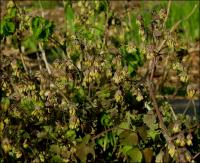Description
ARCHIVED
Note: This is a plant not currently for sale. This is an archive page preserved for informational use.
Hanging chartreuse blooms dangle from the stems in spring
Chartreuse blooms in spring
ARCHIVED
Note: This is a plant not currently for sale. This is an archive page preserved for informational use.
Hanging chartreuse blooms dangle from the stems in spring
ARCHIVED
Note: This is a plant not currently for sale. This is an archive page preserved for informational use.
Clusters of crimson, star-shaped florets atop 2’ stems bloom their heads off ALL summer into fall.
Size: 24-36”x 12”
Care: Sun in well-drained alkaline soil, drought tolerant
Native: Mediterranean
Wildlife Value: attracts butterflies, bees and hover flies.
Centranthus is from the Greek meaning “spurred flower.” According to Culpepper, an English herbalist from the early 1600’s, this plant comforts the heart and stirs up lust. Parkinson, in 1629 describes it “of a fine red colour, very pleasant to behold.”
ARCHIVED
Note: This is a plant not currently for sale. This is an archive page preserved for informational use.
Cheerful, small white daisies flower all summer and autumn.
Size: 18-24” x 12”
Care: Full sun moist well-drained soil
Native: Europe and Caucasus
Common name “Feverfew” speaks for itself, referring to the plant’s medicinal qualities. The species’ name parthenium comes from Plutarch who claimed that the plant saved the life of a construction worker who fell from the Parthenon. Feverfew was prescribed to remedy coughs, indigestion, congestion, melancholy, hysteria, vertigo, freckles, opium overdoses and for “them that are giddie in the head.” Parkinson. A favorite early cottage garden flower. Pressed specimen in Emily Dickinson’s herbarium.
ARCHIVED
Note: This is a plant not currently for sale. This is an archive page preserved for informational use.
Mounds of decorative, silver-edged foliage all summer with sunshine yellow button flowers in October to November
Size: 12-24” x 12-36”can pinch back in June to make compact
Care: sun in well-drained to moist well-drained soil
Native: coasts of Japan
1st described by Japanese botanist Takenoshin Nakai in Botanical Magazine 42: 462. 1928.
ARCHIVED
Note: This is a plant not currently for sale. This is an archive page preserved for informational use.
Pale pink “pussy-toe”, resembling the pads of a kitten’s foot, flowers in early summer, great silvery-gray foliage, good groundcover and rock garden plant.
Size: 2” x 18”
Care: full sun in well-drained soil, drought tolerant
Native: Temperate areas worldwide
Antennaria from the Latin antenna originally referring to the mast of a sailboat. Part of the flower supposedly resembles a butterfly’s antennae. Historically used for medicine as an astringent, a cough remedy and to break fever. First described by German physician and botanical author Leonhard Fuchs (1501-1566). Gertrude Jekyll (1848-1931), mother of the mixed perennial border, planted this in her own rock garden at Munstead Wood and in the Sundial Garden at Pednor House in Buckinghamshire. The pink version, A. dioica rosea, collected in the Rocky Mountains by C.C. Parry before 1860.

